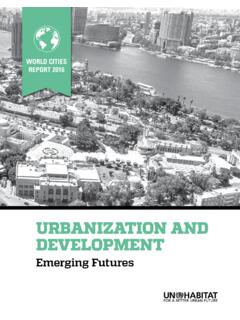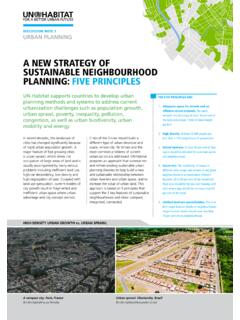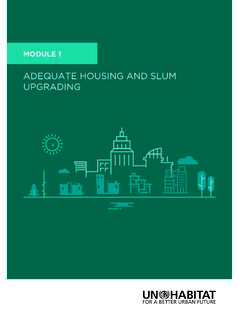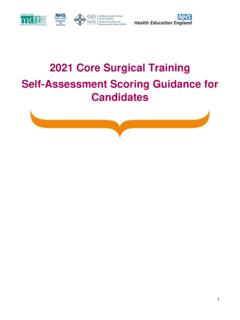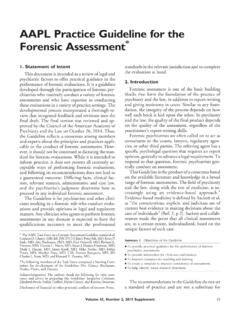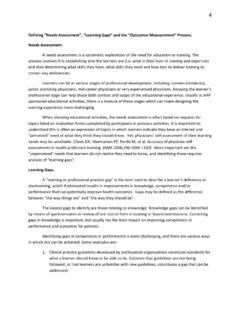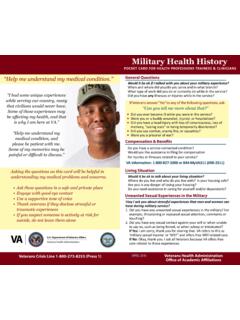Transcription of Manual Training Needs Assessment and Training Outcome ...
1 ManualTraining Needs Assessment and Training Outcome EvaluationIn an Urban Context15 ASSESSMENTEVALUATION Needs Effective entry points Build on previous lessons learned Event, learning and performance Document lessons learned trainee s motivation Barriers & supportPartnersTRAINING Needs ASSESSMENTB eneficiariesManualTraining Needs Assessment and Training Outcome EvaluationIn an Urban ContextManual Training Needs Assessment and Training Outcome Evaluation In an Urban ContextFirst published in Nairobi in 2012 by UN-Habitat. Copyright United Nations Human Settlements Programme 2012 All rights reserved United Nations Human Settlements Programme (UN-Habitat) P. O. Box 30030, 00100 Nairobi GPO KENYA Tel: 254-020-7623120 (Central Office) ISBN: 978-92-1-132497-6 DisclaimerThe designations employed and the presentation of the material in this publication do not imply the expression of any opinion whatsoever on the part of the Secretariat of the United Nations concerning the legal status of any country, territory, city or area or of its authorities, or concerning the delimitation of its frontiers of boundaries.
2 Views expressed in this publication do not necessarily reflect those of the United Nations Human Settlements Programme, the United Nations, or its Member may be reproduced without authorization, on condition that the source is photo UN-HabitatAcknowledgementsThe Capacity Development Unit of UN-Habitat is grateful to all the representatives from Training institutions reviewing an early draft of this Manual during a workshop in Nairobi, April 2011, and Hans Teerlink at the Institute for Housing and Urban Development Studies (IHS) who contributed substantively to the same authors: Hanna Hasselqvist, Laura ThomasProject coordinator: Cynthia RadertContributors: Claudio Acioly, Bernhard Barth, Fernando Cabrera Diaz, Joe Hooper, Bridget Oballa, Hans TeerlinkPeer reviewers: Benjamin Addo (Deutsche Gesellschaft f r Internationale Zusammenarbeit, GIZ), Ayman El-Hefnawi (Housing and Building Research Center, HBRC, Egypt), Samuel Githaiga ( Training Management Consultant, Kenya), Reinhard Goethert (Massachusetts Institute of Technology, MIT), Andre Herzog (World Bank Institute), Yu Hung Hong (Lincoln Institute of Land Policy), Ohene Sarfoh (Institute of Local Government Studies, Ghana)Design and layout: Hanna HasselqvistContact InformationURL: of Appendices.
3 6 List of Figures ..6 Glossary ..9 Training and Capacity Development ..9 The Training Cycle ..9 Determining the Extent of the Assessment and Evaluation ..10 Engaging the Stakeholders ..105. Introduction to Training Outcome Evaluation .. Proving the Value of Training .. Levels of Evaluation .. Meeting the Challenges of Evaluations ..266. Managing the Evaluation Process .. Planning the Evaluation .. Mobilizing Resources .. The Evaluation Team .. Reality Check: Do Benefits Outweigh Costs? ..297. Evaluating Events and Participant Reactions .. Participant Reaction Affects Learning .. Training Content .. Training Delivery .. Training Support ..328. Evaluating Individual Learning .. Why Evaluate Individual Learning? .. What is Learning? .. Methods for Evaluating Individual Learning.
4 349. Job Performance Outcomes and Organizational Performance .. Why Evaluate Job Performance? .. Methods for Evaluating Job Performance .. Individual and Organizational Level Performance Barriers .. Evaluating Organizational Performance and Change ..3710. Learning from the Training Outcome Evaluation ..391. Introduction to Training Needs Assessment .. Assessing Needs and Capacities .. Approaches to Assessment .. Making Sure Training is Relevant ..142. The Training Needs Assessment Process .. Verifying Demand and Client Commitment .. Identifying Key Stakeholders .. Identifying Desired Capacity .. Identifying Current Capacity .. From Current to Desired Capacity .. The Key Question: Can Training Contribute? .. Specifying Training Needs ..183. Collecting and Analyzing Data.
5 Sources of Information .. Data Collection Methods .. Analyzing the Data ..214. Bridging the Assessment and Evaluation through Learning Objectives .. What are Learning Objectives? .. Writing Effective Learning Objectives .. Learning and Behavioural Change .. Translating the Learning Objectives into Training Design ..23 PART 1: Training Needs ASSESSMENTPART 2: Training Outcome EVALUATIONMANUAL Training Needs Assessment AND Training Outcome EVALUATION6 LIST OF APPENDICESDATA COLLECTION METHODS & TOOLSAPPENDIX 1A: Interview Guidelines ..41 APPENDIX 1B: Competency Interview Template ..43 APPENDIX 2A: Group Interview Guidelines (Focus Groups) ..45 APPENDIX 2B: Example of Focus Group Discussion ..46 APPENDIX 3: Observation Guidelines ..47 APPENDIX 4A: Questionnaire Guidelines.
6 48 APPENDIX 4B: Example of Pre- Training Questionnaire ..49 APPENDIX 4C: Post- Training Evaluation METHODS & TOOLSAPPENDIX 5: Problem Tree Analysis ..55 APPENDIX 6: Five Whys ..56 APPENDIX 7: Stakeholder Analysis ..57 APPENDIX 8: SWOT Analysis ..58 APPENDIX 9: KJ Analysis ..59 EVALUATION METHODS & TOOLSAPPENDIX 10: Learning Contract ..61 APPENDIX 11: Performance Contract ..62 APPENDIX 12: Results Chain ..64 APPENDIX 13: Follow-Up Plan ..65 APPENDIX 14: Five W Interview ..67 APPENDIX 15: Learning Improvement Plan ..67 APPENDIX 16: Job Shadow Performance Testing ..69 APPENDIX 17: Action Plan ..69 APPENDIX 18: Outcome Mapping ..71 LIST OF FIGURESFIGURE 1: The Training cycle ..9 FIGURE 2: The main stakeholders in Training ..11 FIGURE 3: The Training Needs Assessment process.
7 15 FIGURE 4: Possible sources for data collection ..19 FIGURE 5: The learning objectives are key in all stages of the Training process following the Assessment ..22 FIGURE 6: Four levels of evaluation ..25 FIGURE 7: The Training Outcome evaluation process ..27 FIGURE 8: Who to involve in the evaluation team?..28 FIGURE 9: Checklist to support decision on whether or not to conduct a Training Outcome 10: The role of evaluating participant reaction in a Training Outcome evaluation ..30 FIGURE 11: The role of evaluating individual learning in a Training Outcome evaluation ..33 FIGURE 12: The role of evaluating job performance in a Training Outcome 13: The role of evaluating organizational performance in a Training Outcome 14: The action learning cycle ..397 GLOSSARYGLOSSARY Capacity Development: The process whereby people, organizations and society as a whole unleash, strengthen, create, adapt, and maintain capacity over Capacity Assessment : A capacity Assessment identifies capacity on three levels; individual, organizational and enabling environment.
8 It is a more comprehensive approach than Training Needs Assessment as it also looks at the interrelation between each of these levels of capacity. Impact: The positive and negative, primary and secondary long-term effects produced by a development intervention, directly or indirectly, intended or Learning: Learning is directly related to increased knowledge and understanding; improved technical, mental or social skills; or changes in attitudes or values. Learning Objective: Learning objectives clearly define what the goal of the Training is: what the trainees are expected to learn from the Training and be able to achieve after the Training . Outcomes: The likely or achieved short-term and medium-term effects of an intervention s Outputs: The products, capital goods and services which result from a development intervention; may also include changes resulting from the intervention which are relevant to the achievement of Training : The passing of knowledge, skills or attitudes from one party or individual to another.
9 Training Needs Assessment : A Training Needs Assessment looks specifically at the skills, knowledge and attitudes of potential trainees. It uses this information to determine if and how the issue can be improved by Training . Training Outcome Evaluation: A Training Outcome evaluation is carried out to see if the objectives of the Training have been met and how the Training process can be improved. Results can be measured on four levels: the event and the participants immediate reactions, the participants learning, the participants job performance, and the organizational performance. Transfer of Learning: The application of learning to the Organisation for Economic Co-operation and Development/The Development Assistance Committee (OECD/DAC), The Challenge of Capacity Development: Working Towards Good Practice, DAC Guidelines and Reference Series, Paris, 2006.
10 Available at ,3746,en_2649_33721_38549470_1_1_1_1, (accessed 2012-05-23)2 OECD/DAC, Glossary of Key Terms in Evaluation and Results Based Management, 2002, p. 24. Available at (accessed 2012-05-23)3 ibid, p. ibid, p. Training Needs Assessment AND Training Outcome EVALUATION8 PREFACEHalf of the world s population already lives in cities. Many cities in developing countries will continue to experience rapid growth rates. In order to manage urban development challenges which will be exacerbated by this growing population pressure, climate change and ongoing devolution of power the need to further develop the capacities of cities to address these will also grow. Within its mandate to promote socially and environmentally sustainable towns and cities UN-Habitat collaborates with and supports Local Government Training Institutions.
